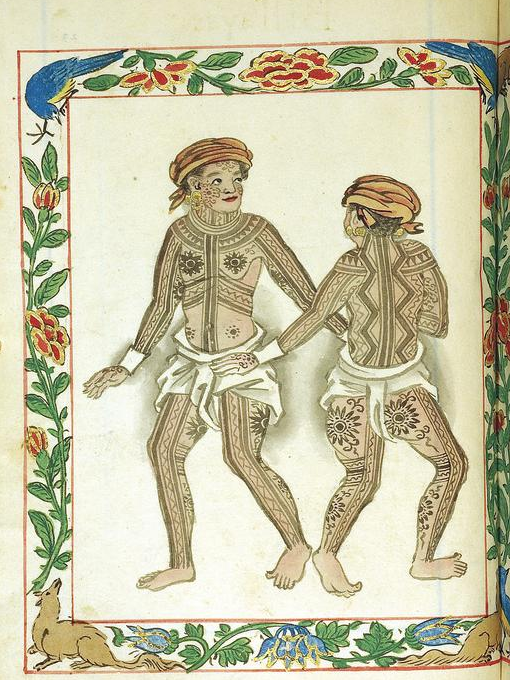“Do you not know that your body is a temple of the holy Spirit within you, whom you have from God, and that you are not your own?” (1 Cor 6:19)
With the spring season in full swing (keep in mind Mr. Suski writes from Australia, Ed.) in so many countries under the Southern Cross, it is nearly impossible to go out in public these days without seeing someone with a tattoo or body piercing. The Land Down Under is experiencing the explosive growth in the proportion of the nation picking out to get inked. Of the Australians having tattoos, almost half (48%) only have one tattoo, 30% have two to three tattoos, and a further 15% have between four and nine, with another 7% having 10 or more tattoos. All in all 19% of the Aussies, that is 1 in 5 have one or more tattoos. The absurdity of it all almost makes one weep, cry or laugh.
Among Christians there are some very different opinions on this subject, at both extremes, ranging from total disapproval to deep admiration. Many find this situation very confusing. The Church has not officially spoken regarding tattoos and it is highly implausible she will do that in the immediate future. Meanwhile, the devil – the iconoclast – is playing possum.
Humans have marked their bodies with tattoos for thousands of years. However, it seems that the nearer people drew to God, the more often they abstained from this practice.
Pursuing a quest for the true nature of tattoos one can find out that they often bore the mark of demonism, Baal worship, shamanism, occultism, and many vile pagan beliefs and practices. The tribal men regarded the ashes of their ancestors as sacred and respected them. In some primitive societies a small amount of cremation ashes was added to regular tattoo ink, to create an ash-infused ink solution. On completion it was offered to local gods.
According to the BBC, the oldest tattoo was discovered on 5,000-year-old Egyptian mummies. The designs were found under the skin and the pigment was likely to be soot. The researchers maintain that “the tattoos would have denoted status, bravery and magical knowledge.”
One must be aware of the fact that indigenous people applied esoteric and intuitive knowledge as a potential source of power for the individual who gained access to it through a tattoo —a source of power that did not depend on existing economic and social level of society.
Tattoos involve the drawing of blood, which in the pagan world was seen as a rejuvenating and immortalizing factor. As stated by ethnologist and anthropologist, the author of “The History of Tattooing”, Wilfrid Dyson Hambly there are numerous reasons why puncturing the skin should be regarded with some degree of awe: “There is in addition the opening of numerous inlets for evil to enter… .”
The faith in one only and true God brought about a significant change in approach to this practice. “Do not lacerate your bodies for the dead, and do not tattoo yourselves.” (Leviticus 19:28) Looking at this scripture in the Bible, God could not make His stand on tattoos any clearer.
Because body tattooing usually in the Roman or Greek world was associated with the barbarians and their mysterious cults, the followers of Christ recognized it as potentially hazardous to their faith. With the development of Christianity the custom of tattooing bodies of slaves and criminals began to abate.
St. Basil the Great, a Doctor and Father of the Catholic Church, condemned tattoos:
“No man shall let his hair grow long or tattoo himself as do the heathen, those apostles of Satan who make themselves despicable by indulging in lewd and lascivious thoughts. Do not associate with those who mark themselves with thorns and needles so that their blood flows to the earth. Guard yourselves against all unchaste persons, so that it cannot be said of you that in your hearts you lie with harlots.”
In A.D. 787, Pope Hadrian put a complete ban on tattooing, and the practice abated, such that it became virtually unknown in the Christian world until the 19th century. Indeed, there were two important exceptions, sailors and coal-miners, both professions that carried serious risks, thus presumably explaining the almost amulet-like use of anchors or miner’s lamp tattoos on men’s forearms. By all means it has nothing to do with Christian faith, as all the ideas of luck and superstition so much common in Anglo-Saxon culture.
It cannot be denied that Coptic Christians in Egypt have received a small cross tattoo on their wrist to declare their Christian identity to the majority Muslim culture, a practice that dates back to the 7th century and the Islamic conquest of North Africa. But it is an exception that proves the rule.
As maintained by Steve Gilbert – ‘Tattoo History: “When Cortez and his conquistadors arrived on the coast of Mexico in 1519, they were horrified to discover that natives not only worshipped devils in the form of status and idols, but also had somehow managed to imprint indelible images of these idols on their skin. The Spaniards, who had never heard of tattooing, recognized it at once as the work of Satan.”
In that respect, it should also be recalled the Nazi practice of forcibly tattooing concentration inmates as part of the German identification system. SS Bolt Tattoos were worn by members of the Waffen-SS to identify a soldier’s blood type in case of a transfusion.
After WW II, tattoos were mainly associated with decadent freaks and fringe groups whose members usually intended to demonstrate their diversity in a negative sense – “I am a really bad person”. Many tattoos have evil and witchcraft themes that are portrayed as devil faces, skulls, ugly demonic signs, vulgar pictures, etc. The counterculture of the 1960s made tattoos common and “acceptable”, along with decadence in many other forms, including satanic sects, hippy promiscuity, drug use, and rock music. Before then, Western society deemed tattoos to be “unsavory” or even “repugnant”. Inmate tattoos have always been a popular “prison trademark. Since the 1970s, on the Hollywood scene, men and women who placed all their hopes on fame and fortune, by injecting ink into flesh, have become models for millions of young people in the West.
No wonder: the more I delved deeper into that internal quest for the truest nature of this practice the less it looked spiritually indifferent, and that its prevalence today is a obvious sign of the culture’s explicit denial of the sanctity of the body.
The etymology of the term tattoo is derived from the Tahitian word “tatau” which means “to mark or strike the skin”. It was Captain James Cook and Joseph Banks who introduced it into the English language. Banks’ description is brief but appalling: “It was done with a large instrument about 2 inches long containing about 30 teeth,” he wrote in his journal. “Every stroke…drew blood.”
Anton Szandor LaVey, the founder of the Church of Satan took a stance on this subject – “Tattooing and piercing are basically forbidden by the Bible in the book of Leviticus, and most of the world is ruled by Biblical religious beliefs—even Africa now. I want to encourage anything that’s a statement against Christianity, because over the last 500 years Christian missionaries systematically destroyed virtually all of the world’s diverse cultures, making the world a much less interesting place.” (Modern Primitives: An Investigation of Contemporary Adornment and Ritual by V. Vale)
Fakir Musafar, an American performance artist claimed ”A lot of people have said that the purpose of the tattoo is to do something for the person, to help them realize the individual magic latent within them.” While Andrea Juno, the author of Modern Primitives, noted about tattoos’ having trans-formative properties: “I’ve heard people report a change in their lives after a tattoo.” Even though tattoos are not so explicitly linked to the occult, they are more than a mere decoration.
Catholics should still be more concerned about what exorcists say:
Fr. Antoni Zieliński, an exorcist, remembers a young woman who after her conversion began to attend Mass; however she suffered anxiety because of a tattoo. “It interferes with prayer and receiving the sacraments”- she complained. Besides, she had failed her driving test ten times. As soon as she removed the tattoo the anxiety disappeared and she passed the test.
Fr. Peter Glas, tells of his many experiences in his ministry as an exorcist doing battle with Satan
“In my experience, people who had tattoos had to endure terrible suffering. […] Many say that they have tattooed only a humble butterfly on their back, and literally just in two week’s time, they were under some enormous pressure into getting the second one, the third and so on. […] In my opinion tattoo inks must be demonically processed. […] When I was praying over a tattoo, the face of that person horribly contorted as if it hurt him.”
Hence, any new spiritual problems surrounding tattoos are bound to set alarm bells ringing.
Fr. Winston Fernandez Cabading OP, exorcists says : “not all tattoos are demonic this must be clear, the intention of the artist and the wearer are to be considered”[…] “so a tattoo even if it depicts holy figures may be considered occult because the artist can be an occult practitioner”, added the Dominican.
“I think personally if you’re Catholic and you want a tattoo, it just boils down to prudence,” says 18-year-old Cassidy Constantin. Yet, it all sounds decidedly risky to me. “Refrain from every kind of evil.”(Tes 5:22)
Fr. Sławomir Kostrzewa warns “We often forget that we live in a multidimensional world, and through signs and symbols we can open the door to the action of evil spirits. […] It is the peculiar mode of a pact, usually unwittingly made with a spiritual reality that has nothing to do with God. […] (Addressing to a priest) You, as a minister of Christ’s Church, by showing a holy tattoo, give your acquiescence to other people who not necessarily want to have holy ones.”
The danger of idolatry is not only a temptation from biblical times; it is present in the world today. Many people choose a magic symbol or just a flower claiming that it will bring him good luck which directly contradicts the 1st Commandment: “You shall not have other gods beside me.” (Exodus 20:3)
One of the largest tribal groups that inhabit the western Sahel region (from Senegal to Chad) are the Fulani of whom one of the most heavily tattooed are the Wodaabe. Powdered tree bark, seeds, and leaves are believed to ward off evil words, enemies, or even attract women. Their tattoos reflect this magic because many symbols are associated with fertility.
There are approximately 11,000 officially recognized Catholic saints, among whom there can be found so many renown doctors, theologians, and mystics; nevertheless, the notion of having a tattoo did not even cross their minds, since intuitively, they sensed that it would be against a plan ascribed to the wisdom of God. United with God, imitating Saint Paul, they could say: “yet I live, no longer I, but Christ lives in me;….” (Gal 2:20). Saint Josephine Bakita was a former slave from Sudan who had been tattooed by one of her owners.
Tattoos are not simply ink and color that you etch into your skin. Generally people choose these type of ornaments, not knowing at all, that they might undergo a kind of initiation or a kind of “baptism”, ushering them into an unfriendly spiritual reality. You never know if tattoo ink at the stage of manufacturing was not by a chance consecrated to demons.
One is to be reminded that the human body is a gift from God, therefore it is meant to be treated with care, not maltreated or disfigured. (CCC 2297) Is then our skin a sort of canvas upon which we can etch and carve permanent drawings? Rather not. I might also retort that tattoos can indeed lead to a number of health risks.
Finally, it is worthwhile to recall these powerful words of Blessed Cardinal Wyszyński, written in 1954, during his imprisonment:
“Christ spoke about whitewashed tombs. It is so amazing how modern man seeks to cover up one’s dirt: after all a whitewashed wall does not cease to be dirty inside. Could this be why people paint their faces because they have noticed tombs’ rot? Could this be why they make more and more use of scented water because they are aware of something exuding from within them? Could this be why they dress smartly, because inside they are poor? Do they want to sell old goods in new packaging? Ancient Egyptians dyed their mummies knowing that there was no life in them. Is that history repeating itself here?”
In this October reflection on one of the perils that beset the spiritual life of Christians I wanted to convey insights into the egregious practice of tattooing. Did I succeed? The readers will make the proper judgment.
“You cannot drink the cup of the Lord and also the cup of demons. You cannot partake of the table of the Lord and of the table of demons.” (1 Cor 10:21)











